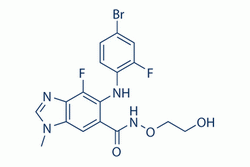| Cas No.: | 606143-89-9 |
| Chemical Name: | 1H-Benzimidazole-6-carboxamide,5-[(4-bromo-2-fluorophenyl)amino]-4-fluoro-N-(2-hydroxyethoxy)-1-methyl- |
| Synonyms: | ARRY 162; ARRY 438162, MEK-162,Binimetinib;MEK-162; ARRY-162; ARRY-438162 |
| SMILES: | CN1C=NC2=C1C=C(C(=C2F)NC3=C(C=C(C=C3)Br)F)C(=O)NOCCO |
| Formula: | C17H15BrF2N4O3 |
| M.Wt: | 441.23 |
| Sotrage: | 2 years -20°C Powder, 2 weeks4°C in DMSO,6 months-80°C in DMSO |
| Description: | Binimetinib (MEK162) is an oral and selective MEK1/2 inhibitor with an IC50 of 12 nM. |
| In Vivo: | Treatment with Binimetinib (ARRY-438162) reduces disease severity in a dose-related manner in both animal models. ARRY-438162 in the CIA model inhibits increases in ankle diameter by 27% and 50% at 1 and 3 mg/kg, while Ibuprofen has 46% inhibition. When combined with Ibuprofen, these same two doses result in 74% and 72% inhibition, respectively. Microscopic examination of the ankle joints show Binimetinib (ARRY-438162) significantly inhibits lesions (inflammation, cartilage damage, pannus formation and bone resorption) by 32% and 60% at 1 and 3 mg/kg, while treatment with Ibuprofen alone results in 17% inhibition, which is not significantly different from the controls. When these two doses of Binimetinib (ARRY-438162) are combined with ibuprofen, the result is 54% and 77% inhibition of joint destruction. In AIA, 3 and 10 mg/kg of Binimetinib (ARRY-438162) inhibit AIA ankle diameter 11% and 34%, while MTX has 33% inhibition. When combined with MTX, 3 and 10 mg/kg of Binimetinib (ARRY-438162) result in 55% and 71% inhibition. Microscopic examination of ankle joints for inflammation and bone resorption also shows improved efficacy versus either compound alone[1]. When Binimetinib (MEK162) is combined with BEZ235, a significant reduction of tumor growth is observed (P=0.01). This increase in antitumor activity is accompanied by a decrease in phospho-ERK and phospho-S6 staining. No significant changes are observed in phospho-4EBP1 staining, a direct target of mTOR activity[2]. |
| In Vitro: | In MCF7 cells, RSK3 or RSK4 expression decreases response to treatment with any of the PI3K inhibitors alone. However, the combination of PI3K inhibition with Binimetinib (MEK162) or BI-D1870 completely reverses the resistance of RSK-expressing cells[2]. Binimetinib (MEK162) blocks basal ERK phosphorylation in all HRAS mutant cell lines. The combination of Everolimus and AZD6244/MEK162 causes a stronger inhibition of S6 kinase than single use of Everolimus on Western blot. The combination of Everolimus and AZD6244/MEK162 also translated in a stronger blockade of cell growth in HRAS mutant cells than single use. Binimetinib (MEK162) shows stronger synergism with Everolimus than AZD6244[3]. |

 To enhance service speed and avoid tariff delays, we've opened a US warehouse. All US orders ship directly from our US facility.
To enhance service speed and avoid tariff delays, we've opened a US warehouse. All US orders ship directly from our US facility.




















